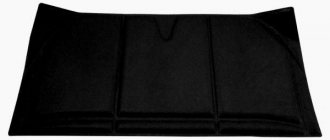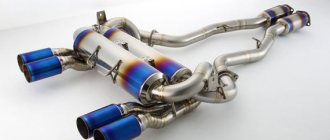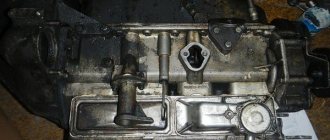Engine insulation
First, let's think about why engine insulation may be needed.
Theory
We all understand that starting a power unit in cold weather is accompanied by significant loads on the rubbing parts. This is due to the fact that at very low temperatures (below -20 degrees Celsius) absolutely any motor oil becomes similar to liquid paraffin, and at even lower temperatures it becomes like solid paraffin. And expensive synthetic ones are no exception, by the way – I’ve seen them myself.
So, after the engine is stopped, the oil slowly flows into the crankcase. Only a thin film of oil remains on the car engine parts. This is how it should be, in fact. Now let’s imagine that the engine has cooled down to at least those -20 degrees. What happened to the oil film, do you think? That's right, it remained, only no longer in a liquid state, but in a solid state. And the oil in the crankcase is not liquid at all.
Accordingly, in winter, from the moment the engine starts until the temperature of the parts rises to the point where the oil becomes liquid, the parts will work without proper lubrication, and the oil pump will not be able to properly provide the power unit with lubrication - try pumping paraffin... Under such conditions, the friction force that occurs between engine parts increases significantly. And this is bad - parts wear out faster, therefore, the engine’s life is reduced faster than planned by its creators.
So where am I going with this? And besides, starting the engine in severe frosts is bad. That is why a reasonable question arises whether it is necessary to insulate the engine - well, so that it is not so difficult for it to start in cold weather.
Is it necessary to insulate the engine?
So is it worth insulating your car engine in winter or not? To give a final answer, you must additionally answer the following questions:
- Will insulation help reduce the load on moving parts of the power unit during a cold start?
- Are there such materials or ready-made solutions for engine insulation?
- Will the insulation create problems for the engine, i.e. Will the power unit operate in the correct mode?
- If you cover the engine, is there a risk of fire?
1.
Let's imagine that the car was parked on the street at night. Accordingly, the motor temperature corresponds to the ambient temperature. Even if the engine is insulated. Let's say it's -30 degrees. Consequently, our oil is in the wrong state of aggregation - instead of a liquid, we have a frozen substance. This means that a cold start of an insulated engine that has been standing all night in the cold will be no different from starting an uninsulated engine. If you look from this position, then insulation is completely unnecessary.
It’s another matter if during the day the car is used in the “drive, stay, drive” mode. In this case, to the question of whether it is necessary to insulate the engine, I think the majority (including myself) will answer positively. A properly insulated engine cools down, judging by reviews from car enthusiasts, about 20-30% longer. Therefore, if the car is actively used during the day, then insulation is definitely advisable.
2.
Currently, there are a lot of different manufacturers on the market that produce the same solution - the so-called “auto blanket”. Nothing new has yet been invented to preserve heat under the hood.
Our grandfathers and fathers tried to cover the engines with felt (at worst, a padded jacket or a battered mattress), and the car radiator was covered with ordinary cardboard from the oncoming air currents. By the way, you can still meet such individuals on our streets. Now – “new technologies”.
While looking for information about different types of insulation, I came across the position of some users that we need to carefully study the composition of the “car blanket” - after all, we will breathe the air that passes through it. You don’t want to get some kind of “sore” because you breathe in harmful substances. Even if the volume of air passing through the insulation is a small fraction of the volume that enters the cabin from the deflectors, I think this position is not without meaning. But this is true, by the way, for general development.
3.
Looking at the variety of options for the same product, you involuntarily ask yourself the question of how to cover a car engine in winter, what kind of insulation to prefer. After all, you need to cover the engine wisely, because there is a possibility of a violation of the cooling technology of the power unit.
How to insulate the engine compartment so that the covering material for insulation does not interfere with the proper operation of the engine? First of all, we are interested in the fact that due to the insulation, the engine will not be fully cooled. This can lead to overheating of the power unit. By the way, if the radiator is closed, then overheating cannot be avoided. Although, it all depends on the temperature outside. Of course, there is no point in thinking ahead, but still, this is a completely logical nuance.
Some people think that it is necessary to cover only the “face” - that is, it is enough to insulate the car’s radiator, but covering the engine is not necessary or undesirable (it is fraught with fires). Some people, on the contrary, don’t even think about whether it is necessary to insulate the engine (for him this issue has already been resolved), but are purposefully looking for a solution on how and how best to insulate the engine, believing that under no circumstances should the radiator be closed - cooling should not suffer.
In general, answering the question whether the cooling process of the power unit will be disrupted if the engine and engine compartment are insulated, I would like to admit that there is no clear answer to this question. It is necessary to experiment. It all depends on the car, the insulation used, insulation technology and climatic conditions.
4.
Very good question. And correct. Regardless of which method of engine insulation is chosen, the chances of a fire increase. And the manufacturer, by the way, will not bear any responsibility for what happened, because you, and only you, will be to blame. They themselves decided how to insulate the car engine for the winter, they themselves decided with what. Not a warranty case.
Previously, felt was considered the best material, because... unlike old padded jackets, mattresses, etc. it does not burn, but chars, or, at most, smolders. Therefore, the risk of fire with its use was minimized. Nowadays, there are more efficient materials that are not only non-flammable, but also resistant to fuels and lubricants, plus they are dielectrics (which means there is nothing to be afraid of a short circuit).
To insulate or not?
So is it worth insulating your car engine in winter or not? The question, as it turned out, is not an easy one. If the car is used infrequently, then the question disappears (it is not advisable to bother with several trips a week or a month), but if the car is used actively, not just daily, but several times a day, then my personal position is this: insulation is a must!
Again, it all depends on the climatic conditions of your region. If in winter your temperature rarely drops below 15-20 degrees, then I think the insulation is more of a “hemorrhoid” than a benefit. And if you are a “happy” resident of the North or equivalent territories of our vast Motherland, where frost -30 is not frost, then I think that the question of whether it is necessary to insulate the engine is not a question for you. Of course we should!
As for whether the insulation will interfere with the engine’s ability to cool properly, I think we have given a more or less clear answer: we need to experiment and use the experience of other motorists from regions with similar climatic conditions. As for the question of whether modern “car blankets” are fireproof or toxic – you just need to study the certificates before purchasing, that’s all.
How to insulate the engine?
If the issue with the need to insulate the engine compartment has been resolved, then a new question arises: how to insulate a car engine for the winter? There are two main options here:
- Purchasing or independently sewing a “car blanket” - a covering heat-insulating shield,
- insulation of the hood cover.
There is another, extreme one: insulating the lower part of the engine compartment. Why did I call it "extreme"? Yes, because I don’t have a very clear idea of what it should look like and what the service life of this “work of folk art” will be.
By the way, if you know how to insulate a diesel engine, then write in the comments, because personally I don’t understand how insulating a diesel engine differs from insulating a gasoline engine.
What can you cover the engine with?
So, here are two options for how to cover a car engine in winter so that it cools down longer and the chance of spontaneous combustion of the insulation is minimized:
- Felt. One of the most affordable materials for engine insulation. Cut to your size. Does not burn, char or smolder.
- Car blanket. Can be found for almost any car. Huge selection of manufacturers. The prices are higher than felt, but you get a finished product. There are uncertified insulation materials whose composition and characteristics cannot be verified. But most are absolutely non-flammable and are dielectrics.
How can you insulate the hood?
List of what to insulate the hood with:
- Izolon,
- folgoisolon,
- penofol,
- tiviplen,
- isoflex,
- stizol,
- polyethylene foam,
- splen,
- USG,
- foamed polyethylene.
All of the materials listed are foamed microporous sheets or rolls. They got their thermal insulation properties (as well as sound insulation, by the way) thanks to their porous structure and small air bubbles.
Some insulation also has options with a foil outer layer. The foil in this case works as a reflector of infrared rays coming from a hot motor. On the one hand, this is a plus - thermal insulation is more effective, and the engine cooling time increases. On the other hand, foil conducts electricity, which means that if it comes into contact with the battery terminals, a short circuit is possible. To avoid a fire, it is necessary to correctly calculate the thickness of the insulation glued to the inside of the hood lid so that it does not reach the battery.
How to insulate an engine with your own hands
I answer the question of those who are interested in how to insulate a car engine with their own hands. If you decide to do everything yourself, then the most affordable option would be this: insulate the hood cover from the inside with isolon, and cover the engine on top with felt. Both can be easily found in the market. This method of insulating the engine compartment is the most budget-friendly. As they say, cheap and cheerful.
Why do you need thermal insulation in the engine compartment?
- Thick oil that does not perform its functions, which accelerates the wear of power unit components.
- Reduced quality of the combustible mixture.
- Difficulty starting the internal combustion engine and intense battery discharge.
- Increased fuel costs due to “cold” engine operation.
- Uncomfortable operation of the car and temporary losses.
A certain part of car owners are limited to the question of how to close the radiator , but this approach is only possible in mild frosts. Already at -20°C, even a closed radiator will not help to quickly warm up the power unit, much less retain heat in the engine compartment after a short stay.
Another argument that stimulates the idea of how to cover a car engine in winter is the ice crust that forms on the hood. Over time, the paint layer will deform and lose its former appearance. After 2-3 cold seasons, the car owner will undergo a procedure to restore the paintwork.
Temperature changes negatively affect the performance of the battery, which is especially evident when starting the internal combustion engine. The level of fuel volatility during a cold start is extremely low, and this factor directly affects the quality of the combustible mixture.
Car insulation
If the feasibility of insulating the engine depends on many factors, then insulating the car as a whole (interior, doors, underbody, etc.) is a completely reasonable question. Especially if you really feel the need for it. Yes, and the cases are different. For example, when you spend the night in a car, and even in winter, you will definitely remember with a kind word the day when you decided to spend a certain amount of money (which is always in short supply) on insulating the doors, bottom, ceiling, etc.
Another thing is that the costs of insulating your car will never come back to you. Therefore, if you doubt that you will use the car for many years, then you need to think carefully about whether the game is “worth the candle.” When selling, none of the potential buyers will give you more than the average market price of this car model.
But this is so, a slight digression from the topic. There are several ways to insulate a car for the winter, which do not exclude, but complement each other:
- you can insulate car doors,
- you can insulate the floor of a car,
- someone even insulates the ceiling in their car.
In general, if you want to prepare your car for a harsh winter, then you should definitely start with insulating the car interior. By the way, at the same time you can solve the issue of noise and vibration insulation - fortunately, many insulation materials can simultaneously fulfill this role.
Insulating a car for the winter is not a difficult, but long process. Therefore, the majority approach this issue purely consumeristly - they give their cars for completion to specialized companies or private owners specializing in body work.
Usually, car insulation is done in the off-season or in the warm season, they say, “prepare the sleigh in the summer.” You can, of course, insulate your car in winter. But you need to take into account that all work must be carried out in a warm place, and the surface of the parts being processed must be as clean and dry as possible. Agree, in cold weather it is much more difficult to achieve this than in the sultry summer.
Door insulation
If you are not afraid of small difficulties, and you have enough free time, then you can insulate the car yourself. The simplest and therefore the cheapest is door insulation. Therefore, it is recommended to start with them.
First, the rubber seals are checked for “fatigue”: are they elastic enough, are they not wrinkled, how tightly do the rubber seals adhere to the body. Closing tightness can be easily checked at speed. It’s enough to listen and run your palm along the entire contour of the doorway - is there any air leaking somewhere?
Failure to close car doors tightly, including due to “dead” seals, is the biggest reason for the interior to quickly cool down. Timely replacement of these parts will certainly give a good result.
Initially, the doors in the car are not insulated with anything. Even if the car belongs to a premium brand and there is good sound insulation in the cabin. Rest assured that the doors are clearly not enough to significantly reduce the time it takes for the interior to cool down to ambient temperature. You will definitely need additional insulation of the doors by removing the door card and gluing the metal from the inside with insulating material. The list of materials that can be used for this is given above, in the section on insulating the hood.
Insulation of the interior
Insulating a car interior with your own hands is a rather labor-intensive process, similar to the process of sound insulation. In the same way, you will have to completely disassemble the entire interior, glue the body parts with insulation, and then reassemble everything. Not everyone will take on this job. Some preparation is needed, I think. You must know how to do it correctly. On the other hand, it is less expensive to insulate a car yourself; in this case, the family budget will suffer to a much lesser extent.
How to insulate a car interior with your own hands? Personally, I would start with the ceiling in the cabin, because... Heat always goes up, not down. If the doors are insulated, only the ceiling remains. And you don't need to disassemble the entire interior.
How can you insulate the ceiling? There are no specific requirements for the material here, because... there are no elevated temperatures, as is the case with the engine compartment. Therefore, you can choose the most affordable material with low thermal conductivity. Cutting pieces of the appropriate size and gluing them onto metal, I think, will be no problem for almost anyone.
The only difficulty will be to remove the casing correctly and carefully and then return it to its place. Don't forget to check the gap between the metal and the sheathing so as not to overdo it with the thickness of the insulation layer.
If you think that it is worthwhile to insulate the car to the maximum, then proceed to gluing the bottom. In my mind, of course, the insulation should be located outside. But unlike real estate, this is impossible in the case of transport. Therefore, you have to disassemble the entire interior in order to get to the metal.
The main thing here is not to leave empty spaces, otherwise everything will go down the drain. And make sure that the insulation sticks as tightly as possible. Otherwise, the gaps and bubbles will subsequently fill with condensate, and the metal will begin to rot. It will be like with medicines: we treat one thing, cripple another. Try to avoid this - you are doing it for yourself.
Industrial samples of car blankets for power units
Modern industry quickly responds to any needs of the population, including car enthusiasts. The consumer is given the opportunity to choose unique insulation materials that are not only completely fire-resistant, but can also withstand temperatures up to 1,200°C. The material itself is environmentally friendly and inexpensive. If anyone does not want to tinker with a homemade heat insulator, then this option is for him.
Car blanket from Avtoteplo LLC
A unique car blanket for the engine, which was developed by domestic engineers. It contains:
- Fiberglass.
- Silica fabric.
- Mullite-silica wool.
This composition is not only capable of retaining heat, but also soundproofing the engine compartment. Thus, the question of how to insulate the engine of your car for the winter can be completely removed from the agenda for 1,650 rubles. This is the cost of a blanket 1600 mm wide and 830 mm long, with a cutout for a lock. The manufacturer's range includes other sizes.
The manufacturer warns against buying counterfeits that are found in car dealerships.
Insulation Autoheater from Novosibirsk
Fire-resistant heat insulator that can withstand temperatures up to 800°C. The blanket is able to retain heat during six hours of inactivity and is resistant to alkalis and acids. However, washing the material is prohibited. The cost of the product is in the range of 1,200-1,300 rubles.
Summing up
Insulating your car for the winter is not an easy task. Its solution is always hampered by both doubts about the feasibility of insulating the engine and budget limitations in most cases. I can only say this for sure: if you live in harsh climatic conditions and actively use your car, then you definitely need to insulate it. In terms of comfort, an insulated car cannot be compared with a “naked” phaeton. By insulating you will not only protect your health, but also your vehicle. I tried to answer the question of how to insulate a car with my own hands in this article. Please do not judge strictly if I forgot to mention something. Thank you for your attention!
See also:
- How to wash a car in winter in questions and answers
- Is it necessary to warm up the car engine in winter?
- Should I warm up my diesel engine in winter or not?
- How long does it take to warm up an automatic car in winter?
- Is it necessary to insulate the battery in a car in winter?
- Why turn on the air conditioning in your car in winter?
- Do-it-yourself insulation of a car radiator
- How much gasoline does it take to warm up a car in winter?
How to insulate a car engine for the winter? How to insulate a hood with your own hands
Why is it difficult to start a car engine in winter? For experienced motorists, the answer to this question is obvious. The fact is that in winter, at low temperatures, the properties of almost all technical fluids in a car, primarily fuel and engine oil, change.
In cold weather, oil thickens, and therefore it takes more time to penetrate through the lubrication system directly to the places where parts are lubricated. In other words, for some time after starting, the engine operates in the so-called “oil starvation” mode, which is extremely undesirable because it leads to rapid wear of rubbing parts. In an engine, as a result of such a lack of lubrication, the parts of the cylinder-piston group are primarily affected.
As for fuel, at low temperatures the same gasoline evaporates much worse, which naturally affects the quality of the fuel-air mixture entering the combustion chambers. In addition, in cold weather the chemical processes in the battery slow down, so its capacity decreases. All these factors together lead to problems with starting the engine in cold weather.
This problem needs to be solved using comprehensive methods, preparing the car for the winter season in advance. Among such methods as, for example, the use of special, preferably synthetic, motor oils and the use of ester-based sprays to facilitate starting, insulation of the engine, or rather the engine compartment, plays an important role.
How to insulate the hood?
An almost ideal material for insulating the engine compartment is felt. Unfortunately, today it is not so easy to find, so drivers often use foil-coated polypropylene foam for these purposes.
From a sheet of insulation, using patterns, the required piece is cut out in the shape of the hood and secured with clips over the standard insulation. In summer, the insulation can be removed.











